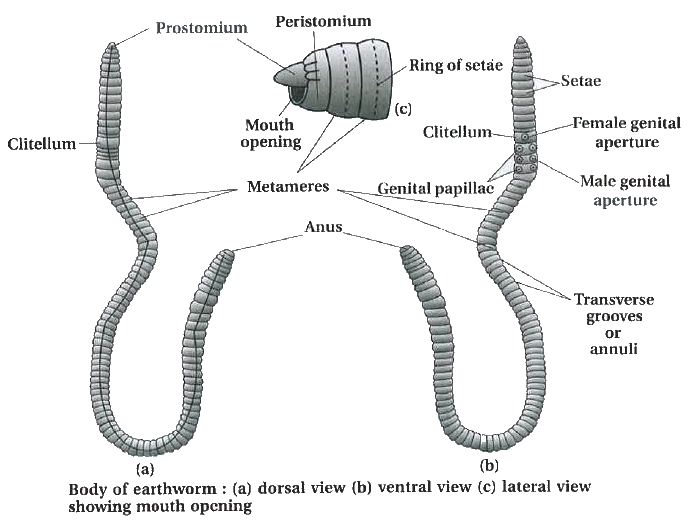Explain external structure of Earthworm with diagramSolution in Gujrati
Earthworm is a reddish brown terrestrial invertebrate. It inhabits the upper layer of the moist soil. During day time, they live in burrows made up by boring and swallowing the soil. In the gardens, they can be traced by their faecal deposits known as worm castings. The common Indian earthworms are Pheretima and Lumbricus. The earthworm is a coelomate animal belongs to Annelida family. Earthworms have long cylindrical body. The body is divided into more than hundred short segments which are 100-120 in number. Its length is 15 cm and breadth is 3-5 line. The dorsal surface of the body is marked by a dark median mid dorsal line (dorsal blood vessel) along the longitudinal axis of the body. Anterior end consists of the mouth and the prostomium. A lobe which serves as a covering for the mouth and as a wedge to force open cracks in the soil into which it may crawl. The first body segment is called the peristomium. The body has no specific head. Whole body is made up of cylindrical segments. Mouth is semilunar in shape and Anus is at the back end. In a mature worm, segments 14-16 are covered by a prominent dark band of glandular tissue called clitellum. Thus the body is divisible into three prominent regions-preclitellar, clitellar and postclitellar segments. The ventral surface is distinguished by the presence of genital openings. Four pairs of spermathecal apertures are situated on the ventro-lateral sides of the intersegmental grooves, i.e., 5th - 9th segments.A single female genital pore is present in the mid-ventral line of 14th segment. A pair of male genital pores are present on the ventrolateral sides of the 18th segment. Genital papillae are located on the ventrolateral sides in 17th and 19th segment. Numerous minute pores called nephridiopores open on the surface of the body. In each body segment, except the first, last and clitellum, there are rows, of S-shaped setae, embedded in the epidermal pits in the middle of each segment. Setae can be extended or retracted. Setae are helpful in obtaining grip in the soil. Setae can’t be seen with naked eyes. They can be taken out or can be pulled back, play an important role in locomotion.

Topper's Solved these Questions
- BOOK - KUMAR PRAKASHANCHAPTER - STRUCTURAL ORGANISATION IN ANIMALSEXERCISE - SECTION-B (Difference/Scientific Reason)9videos
STRUCTURAL ORGANISATION IN ANIMALS
- BOOK - KUMAR PRAKASHANCHAPTER - STRUCTURAL ORGANISATION IN ANIMALSEXERCISE - SECTION-C(DEFINITIONS /EXPLANATION-TERM/LOCATION-FUNCTION)40videos
STRUCTURAL ORGANISATION IN ANIMALS
- BOOK - KUMAR PRAKASHANCHAPTER - SAMPLE QUESTION PAPER FOR SECOND EXAMEXERCISE - SECTION - D1videos
SAMPLE QUESTION PAPER FOR SECOND EXAM
- BOOK - KUMAR PRAKASHANCHAPTER - THE LIVING WORLDEXERCISE - OBJECTIVE SECTION (FILL IN BLANKS)9videos
THE LIVING WORLD
Similar Questions
Simple Epithelium and Compound Epithelium
03:04View SolutionLigaments
04:31View SolutionExplain Double circulation with the help of chart.
04:07View SolutionA .......... is a collection of pressed, dried and preserved plants mounted on ……..
05:23View SolutionGiven below the diagram of alimentary canal of earthworm. Identify the structure (A) and (B).
View Solutionकॉकरोच का वर्गीकरण देते हुए इसकी बाह्र्य संरचना समझाइए।
04:34View Solutionकॉकरोच का वर्गीकरण देते हुए इसकी बाह्र्य संरचना समझाइए।
10:53View SolutionExplain the structure of antibody with diagram.
08:20View Solutionपरीक्षण संकरण व बाह्य संकरण को निरूपण आरेख द्वारा समझाइये।
02:57View SolutionExplain the internal structure of the earthworm.
View SolutionExplain digestive tract of earthworm with diagram.
02:51View SolutionDescribe structure of reproductive system of earthworm with diagram.
04:17View Solutionনিউক্লিওটাইডের গঠনগত অংশগুলি রেখাচিত্রসহ ব্যাখ্যা করো।
03:02View SolutionExplain external and internal structural of uterus.
01:52View SolutionExplain the structure of stomata with a neat diagram.
View Solution

